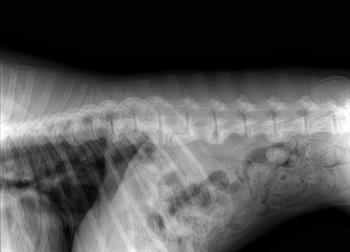Radiograph of a Dog with Spondylosis Deformans

Courtesy of Dr. Dai McWhorter
Spondylosis deformans is a noninflammatory, degenerative condition of the spinal column characterized by the production of bone spurs along the bottom, sides, and upper aspects of the vertebrae. These growths are usually due to aging, injuries like repetitive microtrauma to the same joints and bones through repeated exercise or other activities, major trauma, or a genetic predisposition to bone spurs.
In dogs, spondylosis deformans often occur along the lower back (lumbar) vertebrae. In cats, it tends to occur more often in the chest (thoracic) vertebrae.
Signs
Most affected animals show no signs, although the pet owner may be able to feel the bone spur. The animal may be stiff in the spine and have restricted motion.
If the bony spurs or bridges fracture, the pet may be painful, lame, or show other neuromuscular signs associated with spinal cord or spinal nerve damage. The signs will depend on the location of the deformity in the spine.
Diagnosis
Diagnostic tests may include a physical exam, biochemical profile, complete blood count, urinalysis, electrolyte panel, and diagnostic imaging such as X-rays, computed tomography (CT scan), myelography, or magnetic resonance imaging (MRI). The X-rays will reveal the bony growths, but CT scans, myelography, and MRI may be necessary if the bone spurs are pushing on the spinal cord or associated nerves.
Spondylosis imagelabels_5.2025.docx.jpg - Caption. [Optional]
![Spondylosis imagelabels_5.2025.docx.jpg - Caption. [Optional] X-ray images of normal vertebrae and diseased vertebrae](/AppUtil/Image/handler.ashx?imgid=8790202)
Treatment
Patients without symptoms don't need any treatment.
If your pet is dealing with only pain and stiffness, conservative treatment including weight reduction, controlled exercise or physiotherapy, and non-steroidal anti-inflammatory drugs will usually be recommended.
If a growth is causing more severe pain, or the spur is damaging the nerves or other tissues, as shown by your veterinarian's neurological exam, your veterinarian may advise surgery.
Librela (Dogs)
Based on reports from veterinarians, treatment response to Librela has been mixed, with some animals responding to the injections, some not responding, and some having worsening joint disease and/or adverse reactions including ataxia, seizures, urinary incontinence, vomiting/diarrhea. It is administered by monthly injection. The onset of response is generally within 7–28 days, with the maximum response at 56 days. If there is no response after 2 treatments, alternative therapies should be considered. The drug should not be given to breeding animals, pregnant animals, or lactating animals. It should not be used in animals under 12 months of age.
Solensia (Cats)
Based on reports from veterinarians, treatment response to Solensia has been mixed, but with a slightly better response rate than dogs with Librela. The adverse effects reported with this drug tend to be pruritus, alopecia, vomiting, diarrhea, etc. The drug should not be given to breeding animals, pregnant animals, or lactating animals. It should not be used in animals under 12 months of age and/or under five pounds of body weight.
Ask your veterinarian which treatment options are best suited to your pet’s problem, your schedule, etc. Not all cats are happy to travel to the veterinarian's office once a month for injections, for example.
Prognosis
If there are no symptoms, owners may never know that their pets have or had the condition. Even if dogs or cats have limited flexibility and range of motion, they will live a satisfactory life. Your veterinarian will discuss the prognosis for your pet based on diagnostic testing and/or the response to treatment.